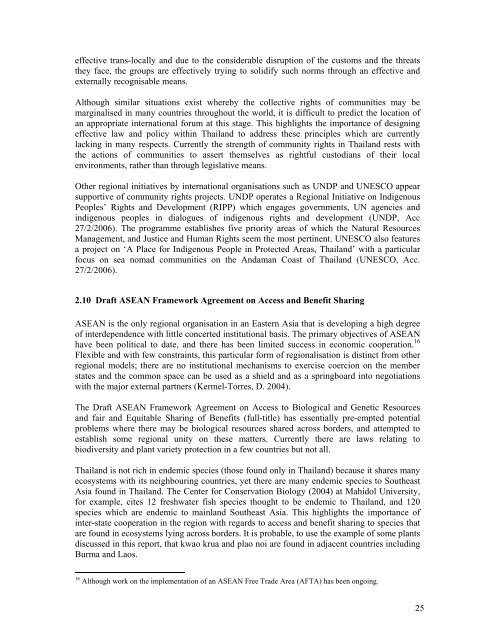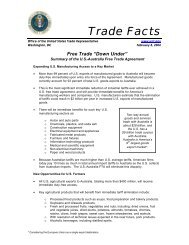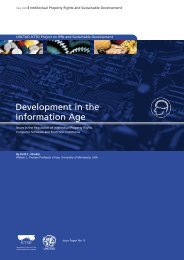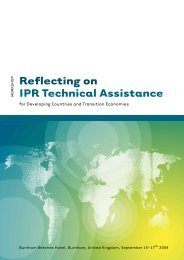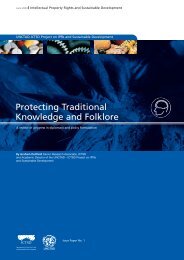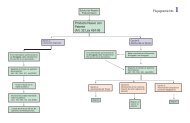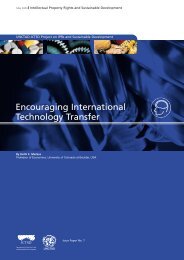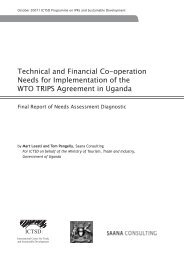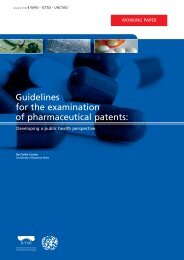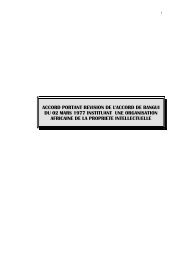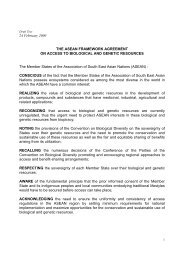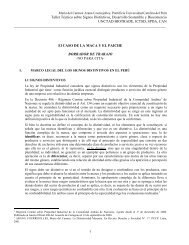Governance and Micropolitics of Traditional ... - IPRsonline.org
Governance and Micropolitics of Traditional ... - IPRsonline.org
Governance and Micropolitics of Traditional ... - IPRsonline.org
Create successful ePaper yourself
Turn your PDF publications into a flip-book with our unique Google optimized e-Paper software.
effective trans-locally <strong>and</strong> due to the considerable disruption <strong>of</strong> the customs <strong>and</strong> the threats<br />
they face, the groups are effectively trying to solidify such norms through an effective <strong>and</strong><br />
externally recognisable means.<br />
Although similar situations exist whereby the collective rights <strong>of</strong> communities may be<br />
marginalised in many countries throughout the world, it is difficult to predict the location <strong>of</strong><br />
an appropriate international forum at this stage. This highlights the importance <strong>of</strong> designing<br />
effective law <strong>and</strong> policy within Thail<strong>and</strong> to address these principles which are currently<br />
lacking in many respects. Currently the strength <strong>of</strong> community rights in Thail<strong>and</strong> rests with<br />
the actions <strong>of</strong> communities to assert themselves as rightful custodians <strong>of</strong> their local<br />
environments, rather than through legislative means.<br />
Other regional initiatives by international <strong>org</strong>anisations such as UNDP <strong>and</strong> UNESCO appear<br />
supportive <strong>of</strong> community rights projects. UNDP operates a Regional Initiative on Indigenous<br />
Peoples’ Rights <strong>and</strong> Development (RIPP) which engages governments, UN agencies <strong>and</strong><br />
indigenous peoples in dialogues <strong>of</strong> indigenous rights <strong>and</strong> development (UNDP, Acc<br />
27/2/2006). The programme establishes five priority areas <strong>of</strong> which the Natural Resources<br />
Management, <strong>and</strong> Justice <strong>and</strong> Human Rights seem the most pertinent. UNESCO also features<br />
a project on ‘A Place for Indigenous People in Protected Areas, Thail<strong>and</strong>’ with a particular<br />
focus on sea nomad communities on the Andaman Coast <strong>of</strong> Thail<strong>and</strong> (UNESCO, Acc.<br />
27/2/2006).<br />
2.10 Draft ASEAN Framework Agreement on Access <strong>and</strong> Benefit Sharing<br />
ASEAN is the only regional <strong>org</strong>anisation in an Eastern Asia that is developing a high degree<br />
<strong>of</strong> interdependence with little concerted institutional basis. The primary objectives <strong>of</strong> ASEAN<br />
have been political to date, <strong>and</strong> there has been limited success in economic cooperation. 16<br />
Flexible <strong>and</strong> with few constraints, this particular form <strong>of</strong> regionalisation is distinct from other<br />
regional models; there are no institutional mechanisms to exercise coercion on the member<br />
states <strong>and</strong> the common space can be used as a shield <strong>and</strong> as a springboard into negotiations<br />
with the major external partners (Kermel-Torres, D. 2004).<br />
The Draft ASEAN Framework Agreement on Access to Biological <strong>and</strong> Genetic Resources<br />
<strong>and</strong> fair <strong>and</strong> Equitable Sharing <strong>of</strong> Benefits (full-title) has essentially pre-empted potential<br />
problems where there may be biological resources shared across borders, <strong>and</strong> attempted to<br />
establish some regional unity on these matters. Currently there are laws relating to<br />
biodiversity <strong>and</strong> plant variety protection in a few countries but not all.<br />
Thail<strong>and</strong> is not rich in endemic species (those found only in Thail<strong>and</strong>) because it shares many<br />
ecosystems with its neighbouring countries, yet there are many endemic species to Southeast<br />
Asia found in Thail<strong>and</strong>. The Center for Conservation Biology (2004) at Mahidol University,<br />
for example, cites 12 freshwater fish species thought to be endemic to Thail<strong>and</strong>, <strong>and</strong> 120<br />
species which are endemic to mainl<strong>and</strong> Southeast Asia. This highlights the importance <strong>of</strong><br />
inter-state cooperation in the region with regards to access <strong>and</strong> benefit sharing to species that<br />
are found in ecosystems lying across borders. It is probable, to use the example <strong>of</strong> some plants<br />
discussed in this report, that kwao krua <strong>and</strong> plao noi are found in adjacent countries including<br />
Burma <strong>and</strong> Laos.<br />
16 Although work on the implementation <strong>of</strong> an ASEAN Free Trade Area (AFTA) has been ongoing.<br />
25


